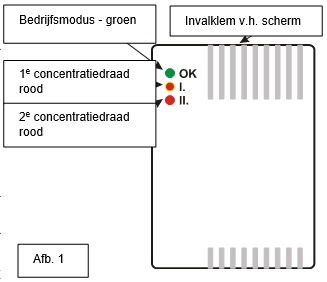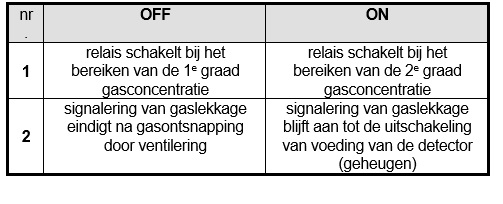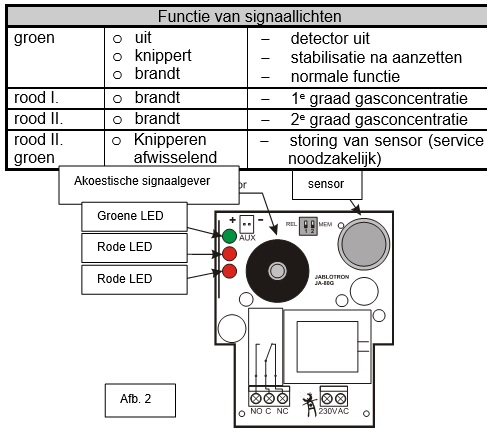Service note for JA-180G Gas leak detector The JA-180G detector ensures the timely detection of leaks of flammable gases (natural gas, light gas, propane, butane) and combustible vapours. Powered directly from the el. mains, the detector signals gas leaks optically, acoustically and also transmits information via Jablotron radio protocol. InstallationThe...
JA-180G
Too much choice? Chat or call us at 085-0160316
There are no products in these categories. Shop on.

Service note for JA-180G
Gas leak detector
The JA-180G detector ensures the timely detection of leaks of flammable gases (natural gas, light gas, propane, butane) and combustible vapours. Powered directly from the el. mains, the detector signals gas leaks optically, acoustically and also transmits information via Jablotron radio protocol.Installation
The detector is intended for installation in areas without significant danger - e.g. homes, light industrial areas or boiler houses.
We recommend that installation is carried out in accordance with EN 50244 and by a person with the required electrical engineering qualification!
Open the screen of the detector by pressing the snap-in clip on the side and fasten the rear part of the housing with the panel of electronics using screws at the chosen location. Install the detector for gases lighter than air (natural gas) near the place, above the possible leakage of gas, on the wall, maximum 15 cm below the ceiling or directly on the ceiling. Install the detector for gases heavier than air (propane) close to the floor or at the lowest place in the room/room. Always position the detector so that the entrance and exit openings in the detector screen are in the assumed direction of airflow.

Never install the detector near obstructions that impede natural air circulation, in places where there is a shortage of oxygen and in places, where the operation of the detector may be affected by various odours (smells) or by vapour condensation (e.g. near a cooker). A strong airflow near the detector may also have a negative impact on detection.
Connect the supply conductors, set the internal switches, close the detector's screen, switch on the central unit's (receiver's) learning mode, and finally switch on the detector's power supply.
Power supply terminals
Power from the mains is connected to the terminals marked 230V AC. The connection is via a fixed supply cable. Before turning on the power supply, check the connection and close the detector screen. Never open the detector with the power supply on.
Clamps of the relay
Common contact
NO make contact
NC break contact
The output of the relay can be used for automatic blocking of gas supply via an electric valve, for external signalling of danger, and the like.
Please note: The mains output of the relay does not provide safety interruption!
Internal switches

There are two setting switches inside the detector:
no. OFF ON
1 relay switches on reaching 1st degree gas concentration relay switches on reaching 2nd degree gas concentration
2 signalling of gas leakage ends after gas escape by ventilation signalling of gas leakage remains on until power supply to the detector is switched off (memory)
Function
After power supply is switched on, the detector sends a learning signal to the central unit (receiver) and the green signal light flashes (for approx. 90 sec - detector is stabilising). Then a short beep sounds and the green light stays on continuously, which means, that the sensor is ready to work.
When the concentration of the leaking gas reaches the value of the 1st degree sensitivity, short audio signals ring and the red light I. lights up.
When the gas concentration exceeds the 2nd degree sensitivity, long audio signals ring and the red light II. lights up.
The fact, at which gas concentration the relay will react, is determined by internal switch no.1.
The alarm signal (Fire type) is sent by the detector at the moment of relay activation (i.e. the transmission is influenced by setting of internal switch no.1).
The JA-180G detector does not control the connection to the central unit (receiver), i.e. the system does not report a loss of detector in case of detector power failure.
CAUTION- in case a gas leakage is indicated, prevent the occurrence of fire (ignition) in this room (do not use electric switches, ventilate thoroughly, stop gas leakage, call the fire brigade or gas supplier if necessary).

Maintenance and informative function check
Keep the unit clean and check from time to time if the grille of the lid is permeable, clean it if necessary by gently blowing away the dust.
Reaction of the detector can be tested using a cigarette gas lighter (without flame). Expert calibration of the detector is done by the manufacturer, it is recommended at most 1 year after commissioning.
Technical parameters
Power supply from mains 230V(+10 to -15%) / 50Hz, approx. 2W, besch. class II
Loud alarm 94 dB / 0.3 m
Relay output optional reaction to 1st or 2nd degree
Load capacity relay switching contact max.230 V / 5 A
Operating temperature -10 °C to +40 °C
Relative humidity 25 to 75%
Warming-up time after switch-on approx. 90 s
Activity time up to 10 s
Method of detection catalytic oxidation
Protection IP 30 ( EN 60 529 )
Communication band 868,1MHz, protocol Jablotron
Communication range approx 200m on direct visibility
Dimensions, weight 101 x 74 x 39, 210 g
Constructed for operation in ordinary atmospheric pressure d.i. 86 to 106kPa
Complies with EN 61779-1, EN 61779-4, EN 50130-4, EN 55022, ETSI EN 300220, 60950-1
Designated for environment without significant hazard BE 1 (2000-3)
Sensitivity:


Opm.: O.E.G. = lower explosivity limit, calibrated by iso-butane
The product is designed and manufactured in accordance with the provisions to be applied to it: Government Decree No. 426/2000 Sb., if used according to its intended use.
Note:Although this product does not contain any harmful materials, do not dispose of it in the domestic waste, but dispose of it at the collection point designated for electronic waste.
